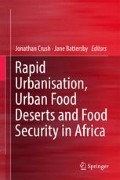Abstract
Despite increased recognition that urban slum dwellers are both extremely vulnerable and highly underserved, the national and international commitment to address urban food crises is constrained by a dearth of information. In Nairobi, Kenya, an estimated 60 % of the population live in slums or slum-like conditions. On average, the Nairobi poor spend 40–50 % of their income on food. This chapter asks whether the livelihood source of the primary breadwinner in the household determines the level of household food insecurity in an urban slum and analyses the predictors of overall food insecurity in a local slum context. Based on a survey of over 3000 households, the study found that having a stable formal job improves the urban household’s food security beyond the significant effect of income. As a corollary, urban dwellers in casual employment with lower and irregular income face chronic food insecurity. The study also found varying levels of food insecurity between different slums and across sub-groups within particular slums for reasons explored in this chapter.
Access this chapter
Tax calculation will be finalised at checkout
Purchases are for personal use only
References
APHRC. (2012). NUHDSS indicators 2003–2012. Nairobi: African Population & Health Research Centre (APHRC).
Alem, Y., & Söderbom, M. (2012). Household-level consumption in urban Ethiopia: The effects of a large food price shock. World Development, 40(1), 146–162.
Amendah, D. D., Buigut, S., & Mohamed, S. (2014). Coping strategies among urban poor: Evidence from Nairobi, Kenya. PloS One, 9(1), e83428.
Bogale, A., & Shimelis, A. (2009). Household level determinants of food insecurity in rural areas of Dire Dawa, Eastern Ethiopia. African Journal of Food, Agriculture, Nutrition and Development, 9(9), 1914–1926.
Candiracci, S., & Syrjänen, R. (2007). UN habitat and the Kenya slum upgrading programme strategy document. United Nations Human Settlements Programme (UNHABITAT): Nairobi.
CARE International in Kenya, Oxfam GB, & Concern Worldwide. (2009). Launch of food security and nutritional analysis in urban informal settlements of Nairobi: Briefing paper. Kenya: Nairobi.
Coates, J., Swindale, A., & Bilinsky, P. (2007). Household food insecurity access scale (HFIAS) for measurement of food access: Indicator guide (V.3). Washington, DC: Food and Nutrition Technical Assistance Project, Academy for Educational Development.
Emina, J., Beguy, D., Zulu, E. M., Ezeh, A. C., Muindi, K., Elung’ata, P., et al. (2011). Monitoring of health and demographic outcomes in poor urban settlements: Evidence from the Nairobi Urban Health and Demographic Surveillance System. Journal of Urban Health, 88(2), 200–218.
Faye, O., Baschieri, A., Falkingham, J., & Muindi, K. (2011). Hunger and food insecurity in Nairobi’s slums: An assessment using IRT models. Journal of Urban Health, 88(2), 235–255.
Fotso, J., Ezeh, A., & Oronje, R. (2008). Provision and use of maternal health services among urban poor women in Kenya: What do we know and what can we do? Journal of Urban Health, 85(3), 428–442.
KNBS. (2007). Basic report on wellbeing in Kenya based on the Kenya intergrated household budget survey—2006/06. Kenya National Bureau of Statistics (KNBS): Nairobi.
Kimani-Murage, E., Schofield, L., Wekesah, F., Mohamed, S., Mberu, B., Ettarh, R., et al. (2014). Vulnerability to food insecurity in urban slums: Experiences from Nairobi, Kenya. Journal of Urban Health, 91(6), 1098–1113.
Mberu, B., Ciera, J., Elungata, P., & Ezeh, A. (2014). Patterns and determinants of poverty transitions among poor urban households in Nairobi, Kenya. African Development Review, 26(1), 172–185.
Mudege, N., & Ezeh, A. (2009). Gender, aging, poverty and health: Survival strategies of older men and women in Nairobi slums. Journal of Aging Studies, 23, 245–257.
Ruel, M., Garrett, J., Morris, S., Maxwell, D., Oshaug, A., Engle, P., Slack, A., & Haddad, L. (1998). Urban challenges to food and nutrition security: A review of food security, health and caregiving in the cities. FCND Discussion Paper No. 51. Washington D.C.: IFPRI.
Schofield, L., Mohamed, S., Kimani-Murage, E. W., Wekesah, F., Mberu, B., Egondi, T., et al. (2013). Spotting the invisible crisis: Early warning indicators in urban slums of Nairobi, Kenya. Field Exchange: Special Focus on Urban Food Security & Nutrition, 45, 55–59.
Tefera, T., & Tefera, F. (2014). Determinants of households food security and coping strategies for food shortfall in Mareko District, Guraghe Zone Southern Ethiopia. Journal of Food Security, 2(3), 92–99.
World Bank & IMF. (2012). Global Monitoring report 2012: Food prices, nutrition, and the millennium development goals. Washington, DC: World Bank.
World Bank. (2006). Kenya—Inside informality: Poverty, jobs, housing and services in Nairobi’s slums. Washington, DC: World Bank.
Zulu, E., Beguy, D., Ezeh, A., Bocquier, P., Madise, N., Cleland, J., et al. (2011). Overview of migration, poverty and health dynamics in Nairobi City’s slum settlements. Journal of Urban Health, 88, 185–199.
Acknowledgments
The funding bodies had no role in the study design, data collection, analysis, decision to publish, or preparation of the manuscript. The authors acknowledge the contribution of Alex Ezeh in the design of the study. The authors are also highly indebted to the data collection team and the study participants.
Author information
Authors and Affiliations
Corresponding author
Editor information
Editors and Affiliations
Rights and permissions
Copyright information
© 2016 Springer International Publishing Switzerland
About this chapter
Cite this chapter
Mohamed, S.F. et al. (2016). Poverty and Uneven Food Security in Urban Slums. In: Crush, J., Battersby, J. (eds) Rapid Urbanisation, Urban Food Deserts and Food Security in Africa. Springer, Cham. https://doi.org/10.1007/978-3-319-43567-1_8
Download citation
DOI: https://doi.org/10.1007/978-3-319-43567-1_8
Published:
Publisher Name: Springer, Cham
Print ISBN: 978-3-319-43566-4
Online ISBN: 978-3-319-43567-1
eBook Packages: Social SciencesSocial Sciences (R0)

